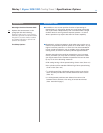
Specifications
Marley
/
Sigma 1000/1200 Cooling Tower
/
Specifications: Options
28
Specification Value
Low Noise Tower:
1.1 Add the following at the end of this
paragraph: The cooling tower shall be
quiet operating, and shall produce an
overall level of sound no higher than ____
dBA at the critical location indicated on
the Plans.
■ Sound produced by a Sigma Steel tower operating in an unob-
structed environment will meet all but the most restrictive noise
limitations – and will react favorably to natural attenuation.
Where the tower has been sized to operate within an enclosure,
the enclosure itself will have a damping effect on sound. Sound
also declines with distance – by about 5 or 6 dBA each time
the distance doubles. Where noise at a critical point is likely to
exceed an acceptable limit, you have several options – listed
below in ascending order of cost impact:
• Where only a slight reduction in noise will satisfy — and the
source of concern is in a particular direction — merely turning
the tower may be the answer. Less sound emanates from the
cased face of the tower than does from the air intake face.
• In many cases, noise concerns are limited to nighttime, when
ambient noise levels are lower and neighbors are trying to
sleep. You can usually resolve these situations by using two-
speed motors in either 1800/900 or 1800/1200 RPM configura-
tion; and operating the fans at reduced speed without cycling
“after hours”. (The natural nighttime reduction in wet-bulb tem-
perature makes this a very feasible solution in most areas of the
world, but the need to avoid cycling may cause the cold water
temperature to vary significantly.)
• Variable speed drives automatically minimize the tower's noise
level during periods of reduced load and/or reduced ambient
without sacrificing the system's ability to maintain a constant
cold water temperature. This is a relatively inexpensive solution,
and can pay for itself quickly in reduced energy costs.
• Where noise is a concern at all times (for example, near a hos-
pital), the best solution is to oversize the tower so it can operate
continuously at reduced (1200 or 900 RPM) motor speed even at
the highest design wet-bulb temperature. Typical sound reduc-
tions are 7 dBA at 2/3 fan speed or 10 dBA at 1/2 fan speed, but
larger reductions are often possible.
• Extreme cases may require inlet and discharge sound attenu-
ator sections; however, the static pressure loss imposed by
attenuators may necessitate an increase in tower size. This is
the least desirable approach because of the significant cost
impact – and because of the obstruction to normal maintenance
procedures.
Y
our Marley representative can help you meet your sound
requirements.


















